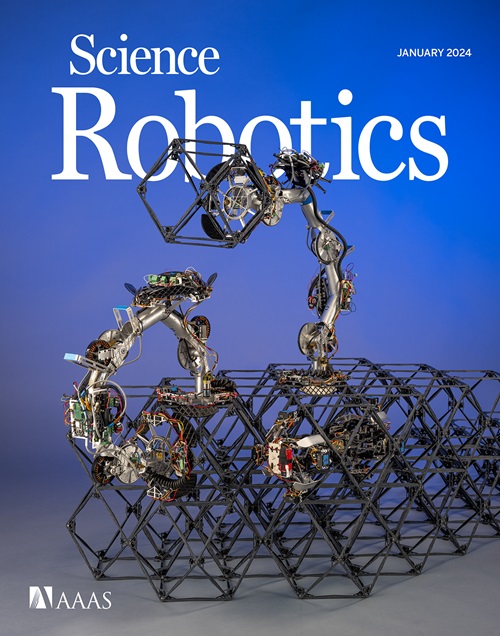能够穿越管状结构的无线流量驱动微型机器人。
IF 26.1
1区 计算机科学
Q1 ROBOTICS
引用次数: 0
摘要
能够在流体流动的管状结构中导航的毫米级无线机器人在核工业、工业和医疗应用中的检查、维护或修理方面具有巨大的潜力。然而,由于普遍依赖外部供电,限制了这些机器人的工作范围和适用环境。机载供电的替代方案必须在尺寸、功能和运行时间之间进行权衡。在此,我们提出了一种毫米级无线轮式机器人,它能够利用环境流为其提供动力,并驱动其在复杂管道中进行长距离运动。水流动力模块可将水流能转化为机械能,叶轮转速可达每分钟 9595 转,输出功率密度为每立方米 11.7 瓦,效率为 33.7%。微型变速箱模块可将转换后的机械能进一步传输到机器人的运动系统中,使机器人能够以平均每秒 1.05 米的速度逆水流运动。机器人的运动状态(逆流/顺流或暂停)可根据不同的控制设计建议,通过外部磁场或机载机械调节器进行切换。此外,我们还设计了基于叽里格米的软轮,用于自适应运动。该机器人可以在具有复杂几何形状和不同材料的管道中逆流移动。仅靠流动提供动力,机器人就能运输直径达管道直径 55% 的圆柱形有效载荷,并携带用于管道检测的内窥镜照相机、用于环境温度监测的无线温度传感器和用于基础设施维护的堵漏器外壳等装置。本文章由计算机程序翻译,如有差异,请以英文原文为准。
Wireless flow-powered miniature robot capable of traversing tubular structures
Wireless millimeter-scale robots capable of navigating through fluid-flowing tubular structures hold substantial potential for inspection, maintenance, or repair use in nuclear, industrial, and medical applications. However, prevalent reliance on external powering constrains these robots’ operational range and applicable environments. Alternatives with onboard powering must trade off size, functionality, and operation duration. Here, we propose a wireless millimeter-scale wheeled robot capable of using environmental flows to power and actuate its long-distance locomotion through complex pipelines. The flow-powering module can convert flow energy into mechanical energy, achieving an impeller speed of up to 9595 revolutions per minute, accompanied by an output power density of 11.7 watts per cubic meter and an efficiency of 33.7%. A miniature gearbox module can further transmit the converted mechanical energy into the robot’s locomotion system, allowing the robot to move against water flow at an average rate of up to 1.05 meters per second. The robot’s motion status (moving against/with flow or pausing) can be switched using an external magnetic field or an onboard mechanical regulator, contingent on different proposed control designs. In addition, we designed kirigami-based soft wheels for adaptive locomotion. The robot can move against flows of various substances within pipes featuring complex geometries and diverse materials. Solely powered by flow, the robot can transport cylindrical payloads with a diameter of up to 55% of the pipe’s diameter and carry devices such as an endoscopic camera for pipeline inspection, a wireless temperature sensor for environmental temperature monitoring, and a leak-stopper shell for infrastructure maintenance.
求助全文
通过发布文献求助,成功后即可免费获取论文全文。
去求助
来源期刊

Science Robotics
Mathematics-Control and Optimization
CiteScore
30.60
自引率
2.80%
发文量
83
期刊介绍:
Science Robotics publishes original, peer-reviewed, science- or engineering-based research articles that advance the field of robotics. The journal also features editor-commissioned Reviews. An international team of academic editors holds Science Robotics articles to the same high-quality standard that is the hallmark of the Science family of journals.
Sub-topics include: actuators, advanced materials, artificial Intelligence, autonomous vehicles, bio-inspired design, exoskeletons, fabrication, field robotics, human-robot interaction, humanoids, industrial robotics, kinematics, machine learning, material science, medical technology, motion planning and control, micro- and nano-robotics, multi-robot control, sensors, service robotics, social and ethical issues, soft robotics, and space, planetary and undersea exploration.
 求助内容:
求助内容: 应助结果提醒方式:
应助结果提醒方式:


